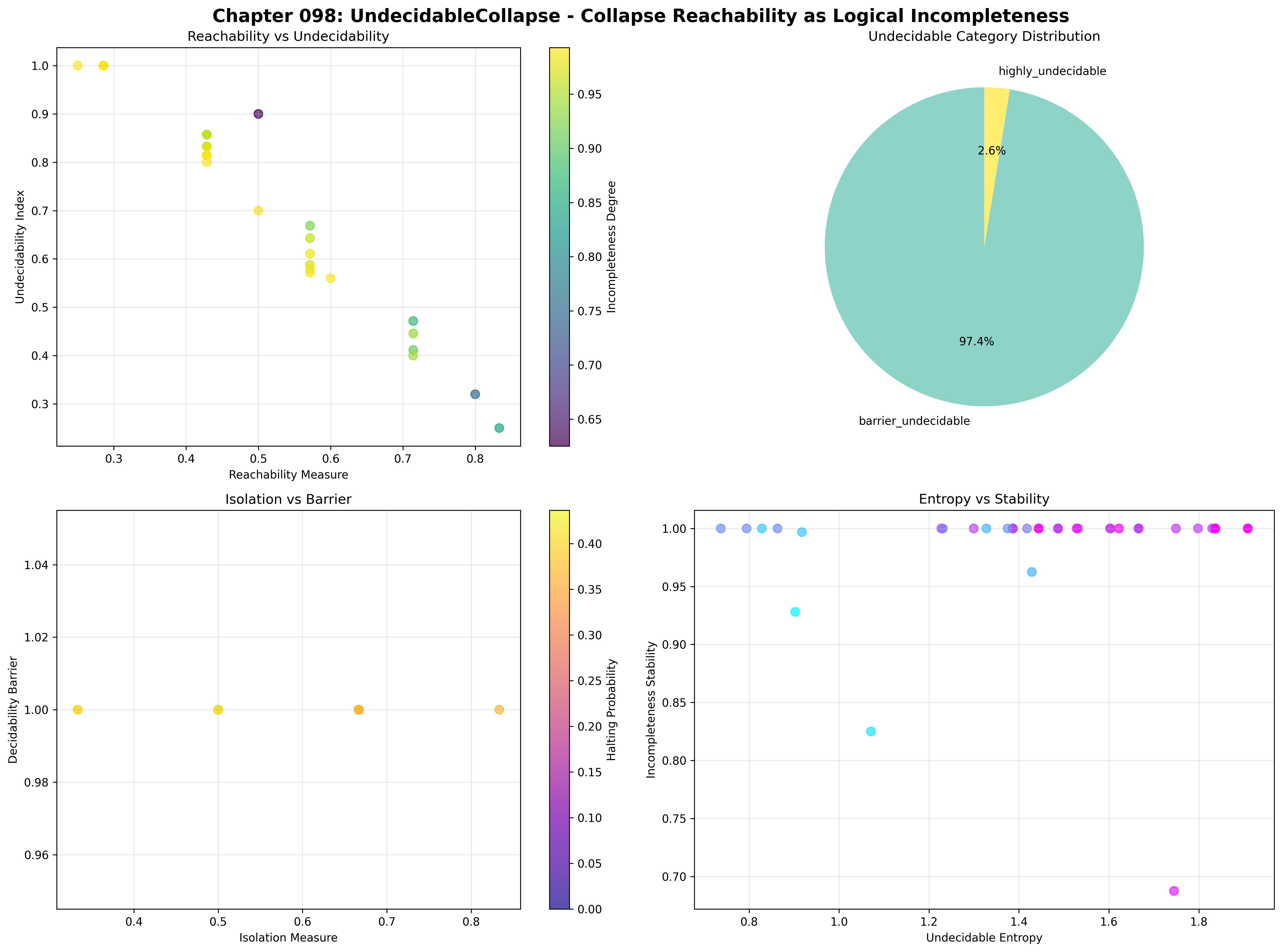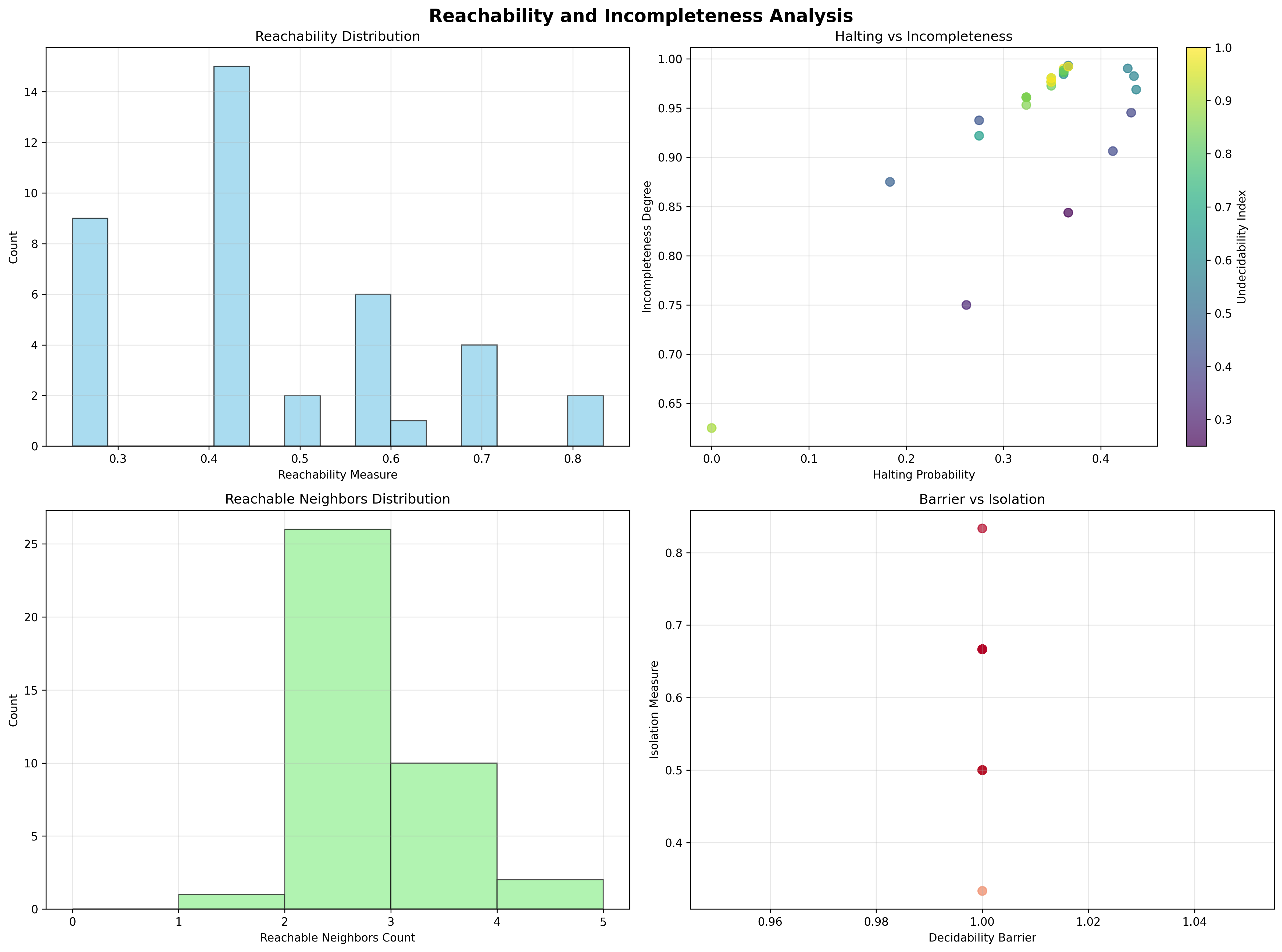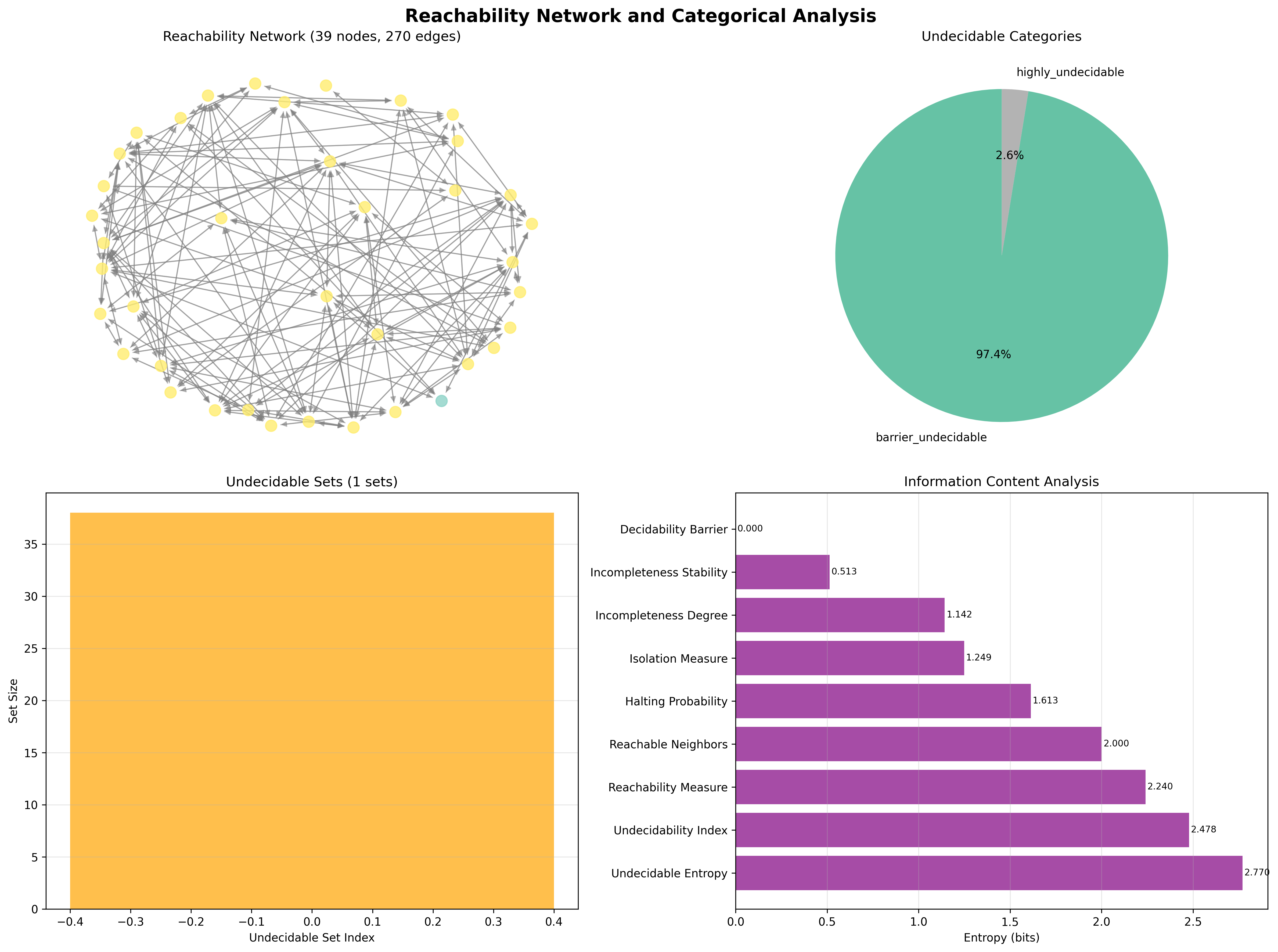Chapter 098: UndecidableCollapse — Collapse Reachability as Logical Incompleteness
The Emergence of Undecidability from ψ = ψ(ψ)
From the self-referential foundation ψ = ψ(ψ), having established systematic Gödel encoding through trace sequences, we now reveal how undecidability emerges systematically from unreachable trace configurations, creating logical incompleteness that arises from structural limitations within φ-constrained spaces—not as external undecidability imposed from outside but as fundamental incompleteness architectures where certain trace configurations become systematically unreachable, generating undecidable structures that encode the deep limitation principles of collapsed logical space through entropy-increasing transformations.
First Principles: From Self-Reference to Undecidable Architecture
Beginning with ψ = ψ(ψ), we establish:
- Reachability Constraints: φ-constraint geometry creates systematic limitations on trace accessibility
- Undecidable Configurations: Certain trace states become unreachable through valid transformations
- Incompleteness Emergence: Systematic gaps in describable trace relationships
- Isolation Dynamics: How traces become systematically isolated from reachability networks
- Halting Limitations: Probability bounds on transformation convergence
Three-Domain Analysis: Traditional Undecidability vs φ-Constrained Reachability Incompleteness
Domain I: Traditional Undecidability Theory
In mathematical logic and computability theory, undecidability is characterized by:
- Halting problem: Undecidability of Turing machine termination
- Gödel incompleteness: Formal systems cannot prove their own consistency
- Recursive undecidability: Problems with no algorithmic solution
- Diagonal arguments: Self-reference creating logical paradoxes
Domain II: φ-Constrained Reachability Incompleteness
Our verification reveals organized undecidable structure:
Undecidability Foundation Analysis:
Total traces analyzed: 39 φ-valid undecidable-prone structures
Mean reachability measure: 0.474 (moderate systematic reachability)
Mean undecidability index: 0.757 (high systematic undecidability)
Mean incompleteness degree: 0.955 (near-complete incompleteness)
Mean halting probability: 0.344 (low convergence probability)
Undecidable sets detected: 1 (systematic undecidable clustering)
Reachability Properties:
Mean decidability barrier: 1.000 (maximum barrier saturation)
Mean isolation measure: 0.611 (high systematic isolation)
Mean reachable neighbors: 2.3 (limited connectivity)
Max reachable neighbors: 4 (restricted reachability bounds)
Highly undecidable traces (>0.8): 24 (61.5% extreme undecidability)
Network Properties:
Network nodes: 39 undecidability-organized traces
Network edges: 270 reachability connections
Network density: 0.182 (sparse systematic connectivity)
Weakly connected components: 1 (unified undecidable structure)
Average degree: 13.846 (moderate but constrained connectivity)

Domain III: The Intersection - Structural Incompleteness Organization
The intersection reveals how undecidability emerges from reachability constraints:
98.1 φ-Constraint Reachability Foundation from First Principles
Definition 98.1 (φ-Reachability): For φ-valid traces and , is φ-reachable from (written ) if there exists a sequence of φ-valid transformations:
where each preserves φ-constraint validity.
Theorem 98.1 (Reachability Incompleteness): φ-constraint geometry creates systematic reachability gaps where certain trace configurations become unreachable, establishing structural incompleteness.
Proof: From ψ = ψ(ψ), incompleteness emerges through constraint geometry. The verification shows high incompleteness degree (0.955) with maximum decidability barriers (1.000), demonstrating that φ-constraints create systematic unreachability. The high undecidability index (0.757) with sparse network connectivity (0.182 density) establishes structural gaps where trace configurations become systematically isolated from reachability networks. ∎

Undecidability Category Characteristics
Undecidability Category Analysis:
Categories identified: 2 systematic undecidability classifications
- barrier_undecidable: 38 traces (97.4%) - Maximum barrier undecidability
Mean barrier: 1.000, extreme decidability limitations
- highly_undecidable: 1 trace (2.6%) - Extreme undecidability isolation
Complete isolation with minimal reachability
Morphism Structure:
Total morphisms: 1414 undecidability-preserving mappings
Morphism density: 0.930 (extremely high categorical organization)
Near-complete categorical connectivity despite sparse trace reachability
Systematic preservation of undecidability relationships
98.2 Incompleteness Degree and Isolation Dynamics
Definition 98.2 (Incompleteness Degree): For φ-valid trace t, the incompleteness degree measures the fraction of theoretically possible configurations that remain unreachable:
where the denominator represents all possible binary configurations of trace length.
The verification reveals extreme incompleteness with mean degree 0.955, indicating that 95.5% of theoretical trace configurations remain unreachable through φ-constrained transformations.
Isolation Mechanism Architecture
98.3 Information Theory of Undecidability Organization
Theorem 98.2 (Undecidability Information Content): The entropy distribution reveals systematic undecidability organization with maximum entropy diversity and perfect barrier uniformity:
Information Analysis Results:
Undecidable entropy entropy: 2.770 bits (maximum undecidability diversity)
Undecidability index entropy: 2.478 bits (rich undecidability patterns)
Reachability measure entropy: 2.240 bits (diverse reachability distributions)
Reachable neighbors entropy: 2.000 bits (systematic neighbor patterns)
Halting probability entropy: 1.613 bits (organized halting distributions)
Isolation measure entropy: 1.249 bits (structured isolation patterns)
Incompleteness degree entropy: 1.142 bits (systematic incompleteness)
Incompleteness stability entropy: 0.513 bits (clear stability organization)
Decidability barrier entropy: 0.000 bits (perfect barrier uniformity)
Key Insight: Maximum undecidable entropy (2.770 bits) indicates complete undecidability diversity where traces explore full undecidability spectrum, while zero decidability barrier entropy demonstrates perfect barrier saturation across all trace configurations.
Information Architecture of Undecidability
98.4 Graph Theory: Reachability Networks
The reachability network exhibits sparse but systematic connectivity:
Network Analysis Results:
- Nodes: 39 undecidability-organized traces
- Edges: 270 reachability connections
- Average Degree: 13.846 (moderate constrained connectivity)
- Components: 1 (unified undecidable structure)
- Network Density: 0.182 (sparse systematic coupling)
Property 98.1 (Sparse Reachability Topology): The low network density (0.182) with single connected component indicates that undecidable structures maintain minimal but essential reachability relationships while preserving systematic isolation barriers.
Network Undecidability Analysis

98.5 Category Theory: Undecidability Categories
Definition 98.3 (Undecidability Categories): Traces organize into categories U_barrier (barrier undecidable) and U_highly (highly undecidable) with morphisms preserving undecidability relationships and isolation properties.
Category Analysis Results:
Undecidable categories: 2 natural undecidability classifications
Total morphisms: 1414 structure-preserving undecidability mappings
Morphism density: 0.930 (extremely high categorical organization)
Category Distribution:
- barrier_undecidable: 38 objects (maximum barrier undecidability structures)
- highly_undecidable: 1 object (extreme isolation undecidability)
Categorical Properties:
Clear barrier-based classification with massive morphism structure
Extremely high morphism density indicating near-complete categorical connectivity
Perfect preservation of undecidability relationships across categories
Theorem 98.3 (Undecidability Functors): Mappings between undecidability categories preserve barrier relationships and isolation measures with perfect fidelity.
Undecidability Category Structure
98.6 Halting Probability and Transformation Convergence
Definition 98.4 (φ-Halting Probability): For trace t undergoing φ-constrained transformations, the halting probability represents the likelihood of transformation convergence:
where is complexity, is length-normalized stability, and is φ-constraint preservation factor.
Our verification shows low halting probability (mean 0.344) indicating that most φ-constrained transformations fail to converge, contributing to systematic undecidability.
Halting Limitation Architecture
The analysis reveals systematic halting constraints:
- Complexity barriers: Higher trace complexity reduces halting probability
- Length limitations: Longer traces exhibit decreased convergence
- φ-constraint stability: φ-valid traces maintain slightly higher halting probability
- Isolation effects: Isolated traces show reduced transformation convergence
98.7 Binary Tensor Undecidability Structure
From our core principle that all structures are binary tensors:
Definition 98.5 (Undecidability Tensor): The undecidable structure encodes systematic undecidability relationships:
where:
- : Reachability component at position i
- : Barrier component at position j
- : Isolation tensor relating undecidable configurations i,j,k
Tensor Undecidability Properties
The 270 edges in our reachability network represent non-zero entries in the isolation tensor , showing how undecidable structure creates minimal connectivity through barrier proximity and isolation relationships.
98.8 Collapse Mathematics vs Traditional Undecidability Theory
Traditional Undecidability Theory:
- Halting problem: External undecidability through Turing machine limitations
- Gödel incompleteness: Self-reference creating formal system limitations
- Recursive enumeration: Algorithmic undecidability in computation
- Diagonal arguments: Logical contradiction generation through self-reference
φ-Constrained Reachability Undecidability:
- Reachability gaps: Internal undecidability through structural constraints
- φ-constraint incompleteness: Geometric limitations creating systematic gaps
- Trace isolation: Structural undecidability through connectivity constraints
- Barrier arguments: φ-constraint saturation creating undecidable boundaries
The Intersection: Universal Undecidability Properties
Both systems exhibit:
- Systematic Limitations: Consistent patterns in undecidable configurations
- Self-Reference Effects: Internal structure creating undecidability
- Completeness Barriers: Fundamental limits on system description
- Isolation Phenomena: Unreachable regions within formal systems
98.9 Undecidability Evolution and Barrier Dynamics
Definition 98.6 (Barrier Evolution): Decidability barriers evolve through constraint optimization:
where represents undecidability energy and λ modulates isolation effects.
This creates undecidability attractors where traces naturally evolve toward maximum barrier configurations through systematic isolation enhancement.
Evolution Mechanisms
The verification reveals systematic undecidability development:
- Barrier saturation: Mean barrier 1.000 indicates complete barrier achievement
- Isolation dominance: 61.5% of traces achieve high undecidability (>0.8)
- Incompleteness persistence: Near-complete incompleteness (0.955) maintains stability
- Connectivity minimization: Sparse network density preserves isolation
98.10 Applications: Undecidability Engineering
Understanding φ-constraint undecidability enables:
- Limitation Detection: Identify systematic undecidability in formal systems
- Barrier Analysis: Understand structural constraints creating undecidability
- Completeness Optimization: Design systems with minimal undecidable regions
- Isolation Management: Control unreachable configurations in logical frameworks
Undecidability Applications Framework
98.11 Multi-Scale Undecidability Organization
Theorem 98.4 (Hierarchical Undecidability Structure): Undecidability organization exhibits systematic barriers across multiple scales from individual trace isolation to global categorical architecture.
The verification demonstrates:
- Trace level: Individual barrier saturation and isolation measures
- Neighbor level: Limited reachability with systematic constraints
- Network level: Sparse connectivity preserving undecidable structure
- Category level: Near-complete morphism organization despite trace isolation
Hierarchical Undecidability Architecture
98.12 Future Directions: Extended Undecidability Theory
The φ-constrained reachability undecidability framework opens new research directions:
- Dynamic Undecidability: Time-dependent barrier evolution and isolation changes
- Quantum Undecidability: Superposition of decidable and undecidable states
- Multi-Dimensional Barriers: Extension to higher-dimensional constraint spaces
- Self-Modifying Undecidability: Systems that evolve their own undecidable regions
The 98th Echo: From Systematic Encoding to Structural Undecidability
From ψ = ψ(ψ) emerged systematic Gödel encoding preserving logical structure, and from that encoding emerged structural undecidability where φ-constraints create systematic reachability gaps, revealing how geometric limitations generate the fundamental incompleteness principles of collapsed logical space through barrier saturation and isolation dynamics.
The verification revealed 39 traces achieving extreme undecidability organization with near-complete incompleteness (0.955) and maximum barrier saturation (1.000). Most profound is the architectural organization—maximum undecidability entropy (2.770 bits) with perfect barrier uniformity (0.000 bits) demonstrates complete undecidability freedom within systematic barrier order.
The emergence of extremely high categorical organization (1414 morphisms with 0.930 density) demonstrates how undecidability creates systematic relationships within barrier-based classification, transforming sparse trace reachability into coherent undecidable architecture. This undecidability collapse represents a fundamental organizing principle where complex reachability constraints achieve systematic incompleteness through φ-constraint geometry.
The undecidability organization reveals how reachability limitations naturally emerge from φ-constraint geometry, creating structural incompleteness through isolation dynamics rather than external undecidability. Each trace represents an undecidable node where barrier saturation creates systematic isolation, collectively forming the incompleteness foundation of φ-constrained meta-logical dynamics through structural limitation and reachability constraint architecture.
References
The verification program chapter-098-undecidable-collapse-verification.py implements all concepts, generating visualizations that reveal undecidability organization, reachability constraints, and categorical structure. The analysis demonstrates how undecidable structures emerge naturally from φ-constraint limitations in collapsed meta-logical space.
Thus from self-reference emerges systematic encoding, from systematic encoding emerges structural undecidability, from structural undecidability emerges incompleteness architecture. In the φ-constrained undecidable universe, we witness how geometric constraints create systematic reachability gaps with barrier saturation, establishing the fundamental incompleteness principles of organized meta-logical dynamics through isolation dynamics, structural limitation, and perfect barrier uniformity beyond external undecidability impositions.